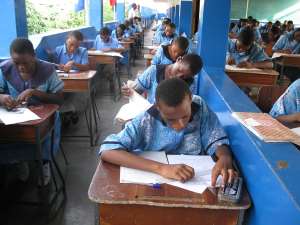
Globally, just one third of countries have achieved all of the measurable Education for All (EFA) goals set in 2000. None achieved them in sub-Saharan Africa; only seven countries in the region achieved even the most watched goal of universal primary enrolment. Sixteen of the twenty lowest ranked countries in progress towards ‘Education for All’ are in sub-Saharan Africa.
The 2015 EFA Global Monitoring Report (GMR) “Education for All 2000-2015: Achievements and Challenges” found that the number of children enrolled in primary school in sub-Saharan Africa increased by 75% to 144 million in 2012. However, 30 million children remain out of school in the region. Corruption, conflict, climate change and poverty have hampered progress in many countries.
Nigeria now has more children out of school than when the global goals were set. Inefficient public spending saw the loss of $21 million of education funding leaving a shortfall of 220,000 primary school teachers. Niger not only failed to reach any of the goals but also has growing inequality, leaving the poorest far less likely to get a free education than they were in 2000. South Africa and Cabo Verde had both achieved Universal Primary Education in 1999 but have since moved away from the goal. Chad ranks at the bottom of the Education Development Index with less than 70% of children enrolled in primary school.
However, some countries have made remarkable progress since 2000. Progress is especially notable among those who focused on helping the poorest with initiatives including abolishing school fees, providing school uniforms, meals and books. Burundi, the Central African Republic, Ethiopia, Mozambique, Sierra Leone and the United Republic of Tanzania more than halved the percentage of children who had never been to school. South Africa reduced its adult illiteracy rates by two-thirds. Equatorial Guinea had fewer than four girls to boys in primary school in 2000, but has now achieved gender parity. Ghana had pre-primary enrolment rates of only 47% in 1999, but now provides universal access at that level.
“Sub-Saharan Africa has faced many challenges in achieving Education for All. These include the effects of climate change, a fast growing population and protracted armed conflict. Economic growth in the region has not yet led to a significant reduction in poverty, which remains a major barrier to education.” said GMR Director, Aaron Benavot. “Nevertheless countries in the region have made serious commitments—financial and otherwise – to expand education opportunity and improve the quality of education. Governments must find ways, together with international partners, to mobilize new resources to quicken the pace of change in the years to come.”
The GMR makes the following recommendations:
- Complete the EFA agenda: All governments should make at least one year of pre-primary education compulsory. Education must be free: fees for tuition should be abolished; costs for textbooks, school uniforms and transport should be covered. Policy makers should prioritize skills to be acquired by the end of each stage of schooling. All countries should ratify and implement international conventions on the minimum age for employment. Literacy policies should link up with community needs. Gender disparities at all levels must be reduced.
- Equity: Programmes and funding should be targeted to meet the needs of the most disadvantaged. There should be more emphasis on gender equality, including through teacher education and safe school environments. Governments should close critical data gaps in order to be able to direct resources to those marginalized groups most in need.
- Post-2015: Countries should ensure that all children and adolescents complete pre-primary, primary and lower secondary education by 2030. Governments should significantly expand adult learning and education opportunities. The education sector should collaborate closely with other sectors at the national and global levels to improve sustainable development prospects.
- Close the finance gap: The international community, in partnership with countries, must find the means to bridge the US$22 billion annual finance gap for quality pre-primary and basic education for all by 2030.
To download the full Report, summary and other material, please visithttp://en.unesco.org/gem-report/report/2015/education-all-2000-2015-achievements-and-challenges#sthash.lE5nhEsQ.iOjeZFZf.dpbs
*Developed by an independent team and published by UNESCO, the Education for All Global Monitoring Report is an authoritative reference that aims to inform, influence and sustain genuine commitment towards Education for All.
Twitter: @EFAReport/#EduVerdict / Web: http://www.efareport.unesco.org
World Education Blog: http://efareport.wordpress.com




 Prince Harry, Meghan visit Nigeria
Prince Harry, Meghan visit Nigeria
 Ghana’s electoral commission is one that trusts thieves — Omane Boamah
Ghana’s electoral commission is one that trusts thieves — Omane Boamah
 All government cares about is spending more and more money on itself — Dalex Fin...
All government cares about is spending more and more money on itself — Dalex Fin...
 COVID-19: GHS records 57% vaccination coverage
COVID-19: GHS records 57% vaccination coverage
 My government will support churches – Bawumia assures Clergy
My government will support churches – Bawumia assures Clergy
 Mahama, Bawumia and Alan have flatly failed Ghanaians – Kofi Akpaloo
Mahama, Bawumia and Alan have flatly failed Ghanaians – Kofi Akpaloo
 PAC warns public institutions to comply with the Public Procurement Act
PAC warns public institutions to comply with the Public Procurement Act
 Voter registration: NDC slams EC’s refusal to share serial numbers of BVR kits
Voter registration: NDC slams EC’s refusal to share serial numbers of BVR kits
 Akufo-Addo's 'corrupt, yenkyendi cronyism' cost Ghana $190m stake in US Millenni...
Akufo-Addo's 'corrupt, yenkyendi cronyism' cost Ghana $190m stake in US Millenni...
 Don't be 'conduit' to President Akufo-Addo's 'I can't hand over power to Mahama'...
Don't be 'conduit' to President Akufo-Addo's 'I can't hand over power to Mahama'...
